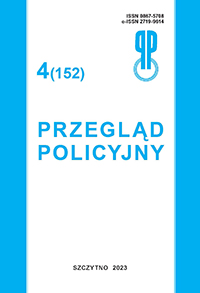Identyfikacja zagrożeń bezpieczeństwa i porządku publicznego na poziomie gminy przy wykorzystaniu aplikacji mobilnej SafeTy
Identification of threats to security and public order at the municipal level using the SafeTy mobile application
Author(s): Jarosław Keplin, Józef Pruchniak, Martyna BluhmSubject(s): Media studies, Public Administration, Security and defense, ICT Information and Communications Technologies
Published by: Akademia Policji w Szczytnie
Keywords: SafeTy application; social ecology; hazard identification; public order; hazards in small towns; hazards to local communities;
Summary/Abstract: The aim of this article is to present the preliminary results of a study on the implementation of the SafeTy application in the municipality of Kaliska, a tool for information exchange and the identification of threats to public safety and order. The problem question posed is: What is the usefulness of the SafeTy application in identifying threats at the rural municipality level? The assumption was that the municipality is responsible for safety and public order and should therefore identify and analyse threats in this area not only on the basis of police statistics. Also important in the research approach was the assumption that the effectiveness of the application is mainly based on the involvement of the local community concerned. Although there are innovative tools in Poland that force a response from the relevant services in the area of security and public order, SafeTy, developed at the Institute of Security and Sociology of the Pomeranian University in Slupsk, is not a notification application. Among other things, it has the potential to be used in identifying threats at the municipal level. Spatial analysis of the distribution of local threats itself has a long tradition. Initially, research into this issue focused on the development of hazard maps. Thanks to technical developments, spatial autocorrelation has emerged, which is used by the SafeTy application. It makes it possible to visualise the areas of concentration of threats in a local space, or the lack thereof. It makes it possible to analyse the intensity of various phenomena in one spatial unit (municipality) in the form of heat maps. Preliminary research shows that the distribution of hazards within a municipality is related to the spatial location of settlements, council housing or places without social control. Some areas of the municipality are simply more stigmatised by threats than others. The article draws on the field of crime geography and thus on the work of the American school of social ecologists. By investigating local threats, the research team showed that SafeTy can be used to analyse the concentration of antisocial behaviour in specific areas of the municipality’s space and to study the dynamics of undesirable events over a specific period, and so on. The results of the presented case study can serve to guide further in-depth analyses and provide research material in this area
Journal: Przegląd Policyjny
- Issue Year: 152/2023
- Issue No: 4
- Page Range: 72-93
- Page Count: 22
- Language: Polish

